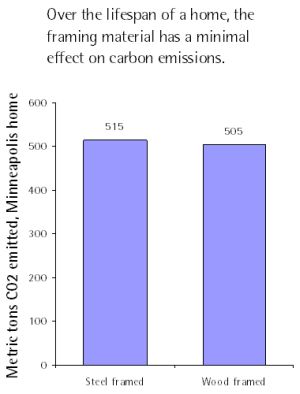Talk about “framing” these days, and many people will think about author and linguist George Lakoff, and the post-2004-election brouhaha about how to communicate, or “frame,” political ideas.
But apparently, there’s much more obscure debate going on about another kind of framing — the kind of framing that goes into building a house.
It’s a bit arcane, really. But the crux of the debate is this: should traditional wood-framing count as a “green” building technique? Or is something else, such as steel or concrete, a more environmentally friendly choice?
On the one hand, some folks are saying that steel and concrete have the edge: they have more recycled content, can last longer without rot or termite damage, and are easier to reuse or recycle when a house is taken down. Plus they leave forests standing, where they can absorb and store more carbon. Houses with steel or concrete framing can sometimes earn credits towards LEED “green building” certification — a fact that the concrete and steel [PDF] industries are more than happy to tout.
On the other side of the debate, there’s CORRIM — the Consortium for Research on Renewable Industrial Materials — a research group loosely affiliated with the University of Washington’s College of Forest Resources.
CORRIM has completed a series of exhaustive life-cycle analyses comparing wood-framed construction with competing steel and concrete technologies. Their findings: manufacturing steel and concrete uses lots of energy — lots — and most of it comes from fossil fuels.
As a result, CORRIM finds, it’s actually more climate-friendly to cut down a forest and use it for timber than to use concrete and steel substitutes whose manufacture relies on coal, oil, or gas.
Now, I’m no expert here — I’m in no position to judge who’s right on the merits.
Still, I think there’s a fair amount of hair-splitting going on. As far as I can tell, focusing on construction materials in isolation — and to the exclusion of other impacts of owning and operating a home — is a mistake.
CORRIM’s studies seem solidly researched. Sure, I’ve got some quibbles, like the fact that they don’t seem to account for soil carbon in their accounting — see, e.g., figure 5.2 in this PDF — even though some northwestern forest soils can store truly immense amounts of carbon — see, e.g., this study. But as a layperson, I’m really in no position to argue with their overall conclusions.
So let’s take a look at their numbers.
I combed through CORRIM’s life-cycle analyses to try to find the total difference, over 75 years, between carbon emissions for a steel-framed vs. a wood-framed home.

And when you add together all life-cycle carbon emissions — for manufacturing and transporting the materials; building the home; maintaining, heating, cooling, and lighting it for 75 years; and dismantling and disposing of it at the end — the difference between the two isn’t much more than a rounding error.
You get a similar result when you look at concrete houses in Atlanta’s climate. (I made the lighting estimate, by the way — CORRIM didn’t include that.)
When I look into CORRIM’s numbers, it’s pretty clear that the big carbon impacts from a home are from heating, cooling, and electric power consumption, which typically have little to do with the choice of framing materials. Far more important than framing are the energy-efficiency features of a house. Excellent insulation, passive heating and cooling, good daylighting, and so on can make a huge difference to long-term climate impacts — far more than the choice of a wood vs. steel frame.
And perhaps more important than any of these is the size of a house. As we’ve mentioned before, a large home built to exacting efficiency standards typically uses more energy than a smaller home that’s not up to modern standards.
Now, CORRIM may well be right about wood vs. steel — and I certainly don’t mean to pooh-pooh a couple of percentage points’ worth of improvement. Every little bit helps.
But from what I’ve heard, some folks are starting to use CORRIM’s analyses to argue for increases in the timber harvest — perhaps on the theory that the higher harvests will make wood cheaper, which would help wood beat out steel and concrete in the construction marketplace.
To me, that makes exactly no sense. Driving down the cost of materials will, in the aggregate, tend to give homebuilders incentives to build larger homes. And larger homes will tend to use more energy than smaller ones. Sure, presuming CORRIM’s analysis is really accurate, you might save a bit of carbon by choosing wood over steel; but you’ll lose way more than that by building a bigger structure.
So we should all take CORRIM’s work for what it’s worth: a nifty way of looking at the life-cycle impacts of building and owning a home. But if you see their work used in favor of ramping up timber harvests, beware: that’s a deceptive way of framing the argument.


